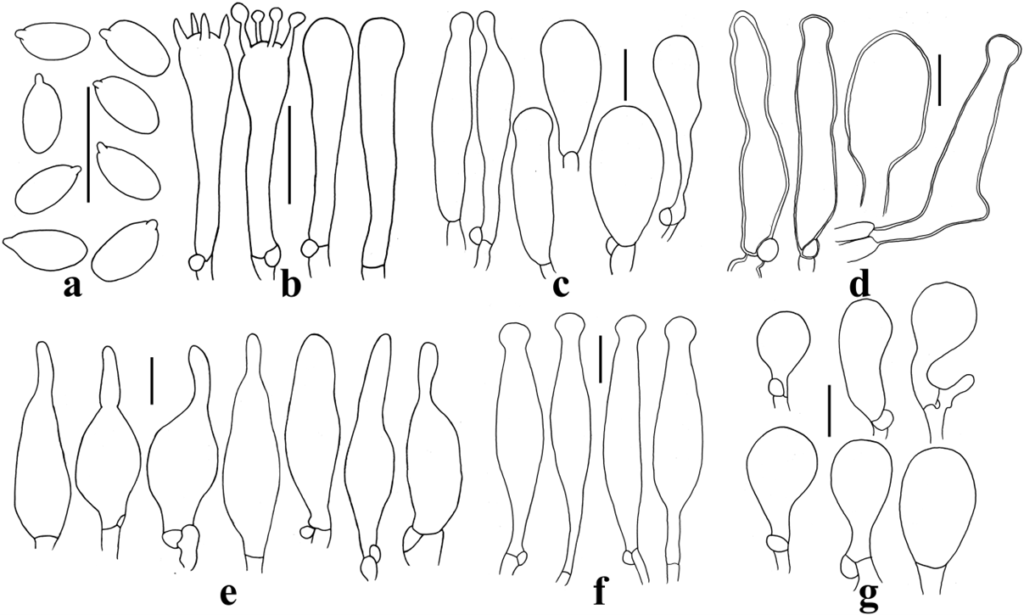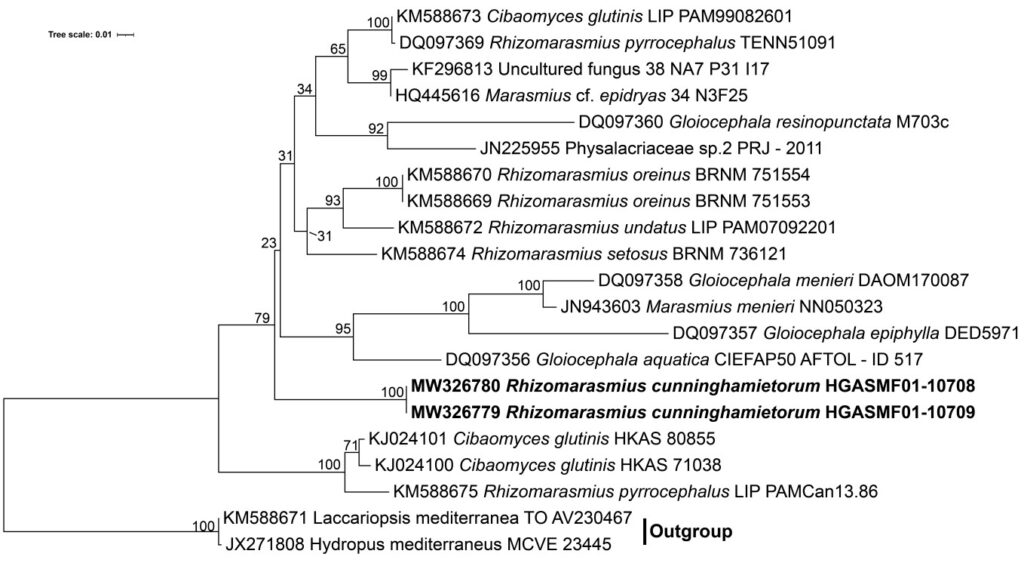Rhizomarasmius cunninghamietorum Chun Y. Deng, J.P. Li & Gafforov
MycoBank number:MB; Index Fungorum number:IF; Facesoffungi Number: FoF 10408;
Species Name Authority, Index Fungorum Number: IF558751
Description
Basidiomata gregarious, marasmioid, marasmielloid or collybioid. Pileus 9–36 mm in diameter, convex to plano-convex when young, expanding to applanate with age, obtuse or slightly depressed at the centre, often wrinkled, slightly sticky, sometimes hygrophanous, translucent when mosit, radially striate or sulcate from the margin up to 3/4 of the radius nearly to the centre, with transversely sulcate between each radial striate when old, involute then inflexed to reflexed at margin, with marginal zone often undulating with age, almost white overall when young, with somewhat milk white (1A2) pigment, then change to generally orange white (6A2), pale orange (6A3) or cinnamon (6D6) overall, paler towards margin, henna (7E8) to dark brown (8E8) at disc when old, darker in the groove, paler at margin. Lamellae adnate, sometimes with slightly decurrently tooth, furcate, intervenose, or anastomosing, often split, linear to ventricose, subdistant, L = 10–14, l = 1–2, white overall, often with light brown (6D4) to reddish brown (8E8) tint, up to 3 mm broad. Stipe 6–23 × 1–3 mm, central, insititious, hollow, pruinose, more or less cylindrical above, sometimes broadened in somewhere, often tapering towards base, pallid at the apex, orange white (6A2) or pale orange (6A3) to dark brown (8E8) below, black at base. Basidiospores (3.5)5–6.5 (7) × 3–4 μm (average= 5.77 × 3.42 μm, E = 1.43–2(–2.16), Q = 1.69), ellipsoid, amygdaliform, thin-walled, non-dextrinoid, hyaline, smooth. Basidia 21–35 × 4.5–6 μm, 4-spored, clavate, hyaline. Basidioles 21–35.5 × 4–6 μm, clavate, cylindrical, hyaline. Cheilocystidia sparse to abundant, 11–50 × 7–17 μm, ellipsoid, cylindrical, irregular clavate, narrowly utriform to narrowly fusiform with capitate apex, thin-walled. Pleurocystidia scattered, sparse, narrowly utriform to narrowly fusiform with capitate apex, 39–64.5 × 7–12.5 μm. Pileipellis a hymeniform layer of clavate to sphaeropedunculate smooth cells measuring 12.5–29.5 × 9–15.5 μm, possibly gelatinized. Pileiocystidia 35.5–51 × 8–16.5 μm, fusiform, narrowly lageniform to lageniform with capitate apex, thin-walled. Stipitipellis a cutis, of cylindrical, parallel, slightly thick-walled, non-dextrinoid, up to 19.5 μm wide hyphae. Caulocystidia 35–59 × 6–12 μm, cylindrical to broadly cylindrical with or without capitate apex, sometimes lobed, thick-walled. Clamp connections present in all tissue.
Material examined: CHINA, Guizhou Province, Qiandongnan Miao Autonomous Prefecture, Liping County, Dongfeng tree farm, on the dead trunk of Cunninghamia lanceolata (Lamb.) Hook., (Cupressaceae), 17 October 2020, Ji-Peng Li (LJP563), HGASMF01-10709 (holotype),
Distribution: CHINA, Guizhou Province.
Sequence data: Type: ITS: MW326779 (ITS1/ITS4); LSU: MW332104(LROR/LR5); Paratype:ITS: MW326780(ITS1/ITS4); LSU: MW332105(LROR/LR5).
Notes: Rhizomarasmius cunninghamietorum has an insititious stipe, a pileipellis as a hymeniform layer of clavate to sphaeropedunculate smooth cells, with narrowly lageniform to lageniform with capitate apex pileocystidia. These morphological characteristics of R. cunninghamietorum are consistent with the circumscription of genus Rhizomarasmius (Moreau et al. 2015). The phylogenetic tree showed R. cunninghamietorum formed a single branch and clearly separate from the known species of Rhizomarasmius and close to its related genera Cibaomyces Zhu L. Yang, Y.J. Hao & J. Qin and Gloiocephala Massee. However, Cibaomyces, a monotypic genus till now, has a subglobose to broadly ellipsoid basidiospores with conspicuous spines and Gloiocephala sensu Singer has smooth spores, subcapitate to capitate cystidia, a gelatinized trama (Singer 1976, 1986) is probably polyphyletic (Moncalvo et al., 2002; Binder et al., 2006; Vizzini et al. 2012; Hao et al., 2014).Thus, the genus Rhizomarasmius is probably polyphyletic based on the phylogenetic analysis generated here. Morphologically, among the known species of Rhizomarasmius, R. epidryas (Kühner ex A. Ronikier) A. Ronikier & Ronikier has entirely brown-black and distinctly velutinose stipe, bigger basidiospores (average 8.85 × 5.7 μm) and narrowly clavate or cylindrical pleurocystidia (Ronikier 2009); R. setosus (Sowerby) Antonín & A. Urb. has a different habitat on leaf petioles and its microscopic features without clamps (Antonín and Noordeloos 2010); Rhizomarasmius oreinus (Pacioni & Lalli) Vizzini, Antonín & A. Urb. has smooth red-brown pileus, entirely tomentose pubescent stipe and bigger basidiospores (average 12.5 × 8.8 μm, Moreau et al. 2015); R. pyrrhocephalus (Berk.) R.H. Petersen has pubescent to tomentose stipe, and bigger basidiospores (average 8.2 × 3.7 μm, Desjardin 1989) and R. undatus (Berk.) R.H. Petersen has longer (5.0–6.3 cm) and strigose stipe (Smith 1836).

Fig. XX. Basidiomata of Rhizomarasmius cunninghamietorum a. HGASMF01-10709 (holotype), b. HGASMF01-10708 (paratype). Scale bars: = 1 cm

Fig. XX. Microscopic structures of Rhizomarasmius cunninghamietorum (holotype). a. Basidiospores, b. Basidia and Basidioles, c. Cheilocystidia, d. Caulocystidia, e. Pileiocystidia, f. Pleurocystidia, g. Terminal cells of pileipellis, Scale bars = 10 μm

Fig. XX. Phylogenetic tree generated from ITS dataset using ML method performed by IQ-tree with 5000 stranded replicates.
